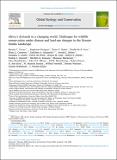Africa’s drylands in a changing world : challenges for wildlife conservation under climate and land-use changes in the Greater Etosha Landscape
Abstract
Proclaimed in 1907, Etosha National Park in northern Namibia is an iconic dryland system with a rich history of wildlife conservation and research. A recent research symposium on wildlife conservation in the Greater Etosha Landscape (GEL) highlighted increased concern of how intensification of global change will affect wildlife conservation based on participant responses to a questionnaire. The GEL includes Etosha and surrounding areas, the latter divided by a veterinary fence into large, private farms to the south and communal areas of residential and farming land to the north. Here, we leverage our knowledge of this ecosystem to provide insight into the broader challenges facing wildlife conservation in this vulnerable dryland environment. We first look backward, summarizing the history of wildlife conservation and research trends in the GEL based on a literature review, providing a broad-scale understanding of the socioecological processes that drive dryland system dynamics. We then look forward, focusing on eight key areas of challenge and opportunity for this ecosystem: climate change, water availability and quality, vegetation and fire management, adaptability of wildlife populations, disease risk, human-wildlife conflict, wildlife crime, and human dimensions of wildlife conservation. Using this model system, we summarize key lessons and identify critical threats highlighting future research needs to support wildlife management. Research in the GEL has followed a trajectory seen elsewhere reflecting an increase in complexity and integration across biological scales over time. Yet, despite these trends, a gap exists between the scope of recent research efforts and the needs of wildlife conservation to adapt to climate and land-use changes. Given the complex nature of climate change, in addition to locally existing system stressors, a framework of forward-thinking adaptive management to address these challenges, supported by integrative and multidisciplinary research could be beneficial. One critical area for growth is to better integrate research and wildlife management across land-use types. Such efforts have the potential to support wildlife conservation efforts and human development goals, while building resilience against the impacts of climate change. While our conclusions reflect the specifics of the GEL ecosystem, they have direct relevance for other African dryland systems impacted by global change.
Citation
Turner , W C , Périquet , S , Goelst , C E , Vera , K B , Cameron , E Z , Alexander , K A , Belant , J L , Cloete , C C , du Preez , P , Getz , W M , Hetem , R S , Kamath , P L , Kasaona , M K , Mackenzie , M , Mendelsohn , J , Mfune , J K E , Muntifering , J R , Portas , R , Scott , H A , Strauss , W M , Versfeld , W , Wachter , B , Wittemyer , G & Kilian , J W 2022 , ' Africa’s drylands in a changing world : challenges for wildlife conservation under climate and land-use changes in the Greater Etosha Landscape ' , Global Ecology and Conservation , vol. 38 , e02221 . https://doi.org/10.1016/j.gecco.2022.e02221
Publication
Global Ecology and Conservation
Status
Peer reviewed
ISSN
2351-9894Type
Journal article
Collections
Items in the St Andrews Research Repository are protected by copyright, with all rights reserved, unless otherwise indicated.

